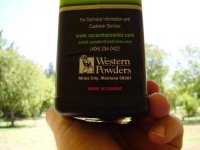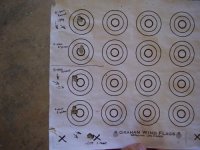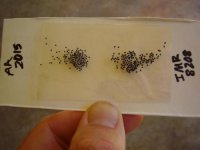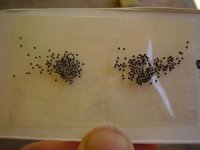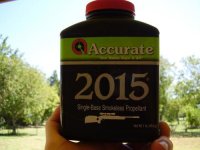Boyd Allen
Active member
If you find powder that is Accurate 2015, labeled as having been made in Canada, it is the identical physical shape and chemical composition as what may be called something like T32, that is currently in the process of being distributed within the benchrest community in a way that makes it likely to get into competitors' hands.
I have some of the slightly slower version that has been on shelves for about a year, and although I may wait for a sample of its faster brother to arrive before taking it to the range for chronographing and a load work up, I did take the time to satisfy my curiosity about how consistently it may be thrown, using a couple of different powder measures.
As most of you probably know, the whole take a Chargemaster to the range thing probably got started because some shooters are of the opinion that there might be an advantage, with 133, given that it is about the upper limit for particle size and shape that can be reliably thrown to competition standards. Honest weighing tells me that with better than average measure technique, the best that that should probably be claimed is +-.15 gr. (Yes, I have done better, but that was after a lot of work, that I do not find typical.)
Now, to the Canadian 2015 (the first attempt at T, good for 3,300). It is a little over .023 in diameter, and length, less the half the size of 133. After determining that my stand on your head and whistle Dixie 133 technique was not the way to go, with a much simpler method, I began weighing charges. At first there were some outliers that opened my ES up to .15 gr. (+-.075gr.), but as I found my rhythm, it got better. I should mention that weighing was done with a tuned up 10-10 and that I am well aware that it is not as good as the best electronic scales, but I have spent enough time checking results with one to have a feel for what I can believe. In any case, my preliminary results tell me that if this powder shoots as good as it measures, I will be very pleased. I think that when I get a hold of a better scale, that it is highly likely that I will be able to hit +-.05 gr. If you like how this powder performs, you may want to think about leaving that Chargemaster at the house and dust off that old powder measure. For those of us who have delayed picking one up, we may have been saved the expense, and trouble.
Added later:
I did a density comparison between the Canadian 2015 and some 2004 133. They were virtually identical in that respect. I threw five charges into a scale pan of one, and weighed them, and then I did the same with the other, same technique, SAECO measure, same setting. The 133 was .1% lighter, which given what I know about how 133 throws means that they are identical. I would expect more difference between five charges of the same powder, thrown and weighed with the same equipment.
Added 1/27 AM:
Just out of curiosity, I pulled out a few particles of '04 133, chasing them around on the sticky side of some scotch tape, with the tips of my dial calipers to try to get an idea of one's size. It was apparent that the size of the particles vary quite a bit, the largest of the few that I looked at was about .030 in diameter, and approximately .050 long.
I have some of the slightly slower version that has been on shelves for about a year, and although I may wait for a sample of its faster brother to arrive before taking it to the range for chronographing and a load work up, I did take the time to satisfy my curiosity about how consistently it may be thrown, using a couple of different powder measures.
As most of you probably know, the whole take a Chargemaster to the range thing probably got started because some shooters are of the opinion that there might be an advantage, with 133, given that it is about the upper limit for particle size and shape that can be reliably thrown to competition standards. Honest weighing tells me that with better than average measure technique, the best that that should probably be claimed is +-.15 gr. (Yes, I have done better, but that was after a lot of work, that I do not find typical.)
Now, to the Canadian 2015 (the first attempt at T, good for 3,300). It is a little over .023 in diameter, and length, less the half the size of 133. After determining that my stand on your head and whistle Dixie 133 technique was not the way to go, with a much simpler method, I began weighing charges. At first there were some outliers that opened my ES up to .15 gr. (+-.075gr.), but as I found my rhythm, it got better. I should mention that weighing was done with a tuned up 10-10 and that I am well aware that it is not as good as the best electronic scales, but I have spent enough time checking results with one to have a feel for what I can believe. In any case, my preliminary results tell me that if this powder shoots as good as it measures, I will be very pleased. I think that when I get a hold of a better scale, that it is highly likely that I will be able to hit +-.05 gr. If you like how this powder performs, you may want to think about leaving that Chargemaster at the house and dust off that old powder measure. For those of us who have delayed picking one up, we may have been saved the expense, and trouble.
Added later:
I did a density comparison between the Canadian 2015 and some 2004 133. They were virtually identical in that respect. I threw five charges into a scale pan of one, and weighed them, and then I did the same with the other, same technique, SAECO measure, same setting. The 133 was .1% lighter, which given what I know about how 133 throws means that they are identical. I would expect more difference between five charges of the same powder, thrown and weighed with the same equipment.
Added 1/27 AM:
Just out of curiosity, I pulled out a few particles of '04 133, chasing them around on the sticky side of some scotch tape, with the tips of my dial calipers to try to get an idea of one's size. It was apparent that the size of the particles vary quite a bit, the largest of the few that I looked at was about .030 in diameter, and approximately .050 long.
Last edited:


